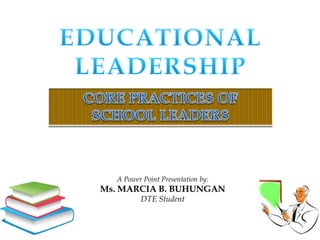
Leadership Practices for School Improvement
- 1. A Power Point Presentation by: Ms. MARCIA B. BUHUNGAN DTE Student
- 2. CONTENTS I. Introduction to Core Practices II. Discussion A. Setting Directions B. Developing People C. Redesigning the Organization D. Managing Instruction (Teaching & Learning) Programme III. Conclusion
- 3. The implications for leadership practice of this account of workplace performance are twofold. First, leaders will need to engage in practices with the potential to improve all elements in the formula – teachers’ and other staff members’ abilities, motivations and the work settings. Second, leaders will need to engage in those practices more or less simultaneously. The overall function of successful leaders is to improve the condition of all three variables. To be successful, therefore, requires leaders to be in possession of a range of cognitive and affective qualities, strategies and skills
- 4. A. SETTING DIRECTIONS 1. Building a Shared Vision A fundamental task in transformational and charismatic leadership One of the 8 core tasks for senior leaders A key mechanism for achieving integration and alignment of activities within the organization Establishment of core values *Core values specify means by which the vision is to be accomplished
- 5. A. SETTING DIRECTIONS 2. Fostering the Acceptance of Group Goals Actions need agreement from the group to fulfil vision Individual member include the organization’s goal among their own Aimed at promoting cooperation and working together toward a common goal Manifested in strategic and improvement processes
- 6. A. SETTING DIRECTIONS 3. High Performance Expectations High performance expectations do not define the substance of organizational goals. They demonstrate the leader’s values, expectations of excellence, quality and/or high performance in the achievement of goals. A central behaviour in virtually all conceptions of transformational and charismatic leadership A. SETTING DIRECTIONS
- 7. B. DEVELOPING PEOPLE 1. Providing Individualized Support/ Consideration Know your followers’ needs and raise them to more mature levels. Use delegation to provide opportunities for them to self- actualize and to attain higher standards of moral development. Provide emotional understanding and support “supporting, recognizing and rewarding” managerial behaviours
- 8. B. DEVELOPING PEOPLE 2. Intellectual Stimulation Behaviours involved: encouraging colleagues to take intellectual risks re-examining assumptions looking at their work from different perspectives rethinking how it can be performed This is where the leader’s role in professional development is found to be key.
- 9. B. DEVELOPING PEOPLE 3. Providing an Appropriate Model This category entails “leading by example” Set of practices: transparency in decision making, confidence, optimism, hope, resilience, consistency between words and deeds Encompasses Bass’ “idealized influence” leaders set an example for employees to follow that is consistent with the values of the leader espouses
- 10. There’s little to be gained by increasing people’s motivation & capacity if working conditions will not allow their effective application. Situation is a fourth source of motivation (Bandura) People are motivated when the environment is conducive Three practices in establishing the working conditions: building collaborative cultures restructuring building productive relationships w/ families & communities C. REDESIGNING THE ORGANIZATION
- 11. C. REDESIGNING THE ORGANIZATION 1. Building Collaborative Cultures Leaders contribute to the productive collaborative activity in their schools by being skilled coveners of that work. They nurture mutual respect and trust by: being trustworthy ensuring the shared determination of group processes and outcomes developing clarity about goals and roles for collaboration
- 12. 1. Building Collaborative Cultures They nurture mutual respect and trust by: encouraging willingness to compromise among collaborators fostering open and fluent communication among collaborators providing adequate and consistent resources C. REDESIGNING THE ORGANIZATION
- 13. C. REDESIGNING THE ORGANIZATION 2. Restructuring A function or behaviour common to virtually all conceptions of management and leadership practice A key mediator of leaders’ effects on students Includes distributing leadership for selected tasks and increasing teacher involvement in decision making
- 14. C. REDESIGNING THE ORGANIZATION 3. Building productive relationships with families and communities Shifting the attention of schools staffs from an exclusively inside-the-school focus to this practice was identified during the 1990s as the biggest change in expectations for those in formal school leadership roles A core practice needed for improving schools in challenging circumstances
- 15. C. REDESIGNING THE ORGANIZATION 4. Connecting the School to its’ Wider Environment Meetings, informal conversations, phone calls, email exchanges and internet searches External support can be a productive response to schools engaged school improvement projects “Networking”, one of eleven critical managerial practices
- 16. D. MANAGING THE INSTRUCTIONAL PROGRAMME 1. Staffing the Programme A key function of leaders engaged in school improvement Goal: Finding teachers with the interest and capacity to further the school’s efforts Recruiting and retaining staff is a primary task leading schools in challenging circumstances
- 17. 2. Providing Instructional (Teaching & Learning) Support Supervising and evaluating instruction Coordinating the curriculum Providing resources in support of curriculum, instruction and assessment activity Controlling behaviour, boosting self esteem and talking & listening to pupils Urging pupils & teachers to place a strong emphasis on pupil achievement D. MANAGING THE INSTRUCTIONAL PROGRAMME
- 18. 3. Monitoring School Activity Monitoring student progress Monitoring operations and environment Tracking student progress is a key task for leaders of schools in challenging circumstances D. MANAGING THE INSTRUCTIONAL PROGRAMME
- 19. 4. Buffering Staff from Distractions to their Work Prevent staff from drifting with agreed goals Acknowledge the open nature of schools & the constant bombardment of staff with expectations from parents, the media, the government, etc “Internal buffering” D. MANAGING THE INSTRUCTIONAL PROGRAMME
- 20. CONCLUSION These are the leadership practices which serve as guide to effective leadership. They may not be applicable all the time, but each have its own use in the most appropriate context. It is the application that must be sensitive to values and context, not the core practices themselves. The core practices provide a powerful source of guidance for practising leaders, as well as a framework for their initial and continuing development.
Hinweis der Redaktion
- INSTRUCTION: Teaching and Learning!
